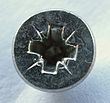Pozidriv
Pozidriv [ ˈpɔzɪ.draɪv ] ( PZ for short ) describes a screw drive with a cross-slot profile . It is a registered trademark and was created as a further development of the Phillips Recess System (PH).
In contrast to the Phillips system, in the Pozidriv system the four flanks of the matching output (i.e. the screwdriver blade tip) do not taper towards the tip, but are milled plane-parallel. There is therefore no connection between the axial pressure of the tool on the screw and its tightening torque .
During production, the blade is ground in from four sides in two steps with cylindrical disks . This enables plane parallelism to be achieved (the Phillips blade, on the other hand, is ground in just one step on each side with a disc in the shape of a double truncated cone). Between the four blades of the screwdriver there is a triangular profile that increases towards the handle.
Pozidriv drives are identified with the abbreviation PZ and a size index (in increasing size PZ 0, PZ 1, PZ 2, PZ 3, PZ 4, PZ 5).
Distinction
Pozidriv screws and screwdrivers are labeled to distinguish them from other Phillips-head screws. Screws have a small mark at 45 degrees to the Phillips head. There are small roof-shaped bumps on the screwdrivers (see arrow in the illustration). The real difference lies in the shape of the slots. The width of PZ screws is constant (see red straight line in the figure). In contrast to this, for example, with PH screws, the slots taper (see red circle segment in the figure). Even if Pozidriv and Phillips recess screws and tools look similar, they only fit perfectly with the respective type and size. If the size or type is not the right one, the output easily damages the screw.
Advantages and disadvantages
Pozidriv was developed as a further development of the Phillips recess cross recess for screwing at higher speeds with torque-limited machines. A torque limitation is therefore necessary when screwing in with a machine. Phillips screwdrivers can be used to a limited extent for Pozidriv screws, but they have play. Pozidriv screwdrivers, on the other hand, cannot be used for Phillips screws - they do not fit into the conical slot, and if a screwdriver one size smaller is used, high torque cannot be transmitted.
use
Pozidriv is rarely used in metal and mechanical engineering . The Pozidriv system is used in practice today for countersunk head screws for craftsmen and DIY enthusiasts , typically nail screws and screws for chipboard . In the woodworking trade, there is an increased tendency towards Torx screws, since there is practically no more axial force to be applied and the maximum torque that can be transmitted is higher.
See also
Web links
- Phillips - Information about Pozidriv


